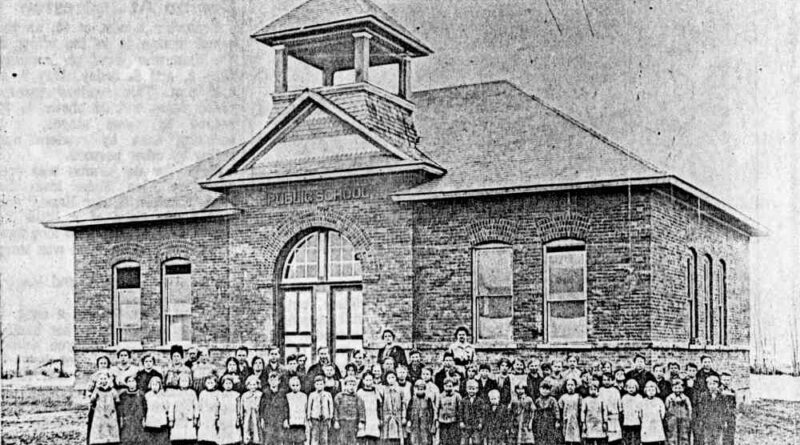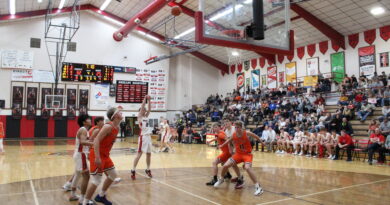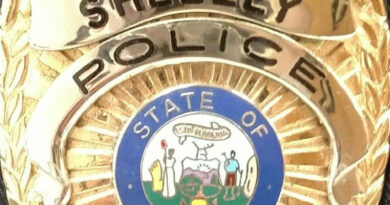Jameston – Taylor Ward History by Marie Manwaring Anderson Nov. 1989
SHELLEY — In November 1989, Marie Manwaring Anderson (1913-2002) wrote the histories of the Jameston and Taylor congregations of The Church of Jesus Christ of Latter-day Saints. The history spans from 1834 to 1987 She also included brief histories of various families in the Jameston and Taylor areas.
Austin Prestwich provided Community Pioneer with the original documents.
Page 1
1834 — First Fort Hall
1843– Emigrants on the Oregon Trail
1855 — Fort Hall abandoned.
1865 — Fort Hall Indian reservation established
1883 — Railroad built through Shelley
1885 — John, Edward and Wm. Priest, Smith Johnson, Edward Wadsworth, and Abiah Wadsworth came down from Ammon, settled in the Taylor area
There were now six families in Taylor. None in Jameston. There was only one old log cabin between these people and the river to the west. Sagebrush as high as a man, and grass which grew up to a horse’s belly in summer. A few willow trees along the creek. The creek was clean and pure and they got their drinking water from it. There were a few families at Basalt.
One woman’s diary states that there were 6 families in this area and they held church in each other’s homes, each taking their turn. She said “Oh the cooking and cleaning that went on to prepare for Sunday.” If one family did not come, they would know that they had sickness or something. They held Sunday school, then all had dinner together. At two o’clock they held sacrament meeting. On the first Thursday of each month they would all fast and take their fast offerings to meeting that evening.
At this time, all of the territory from below Pocatello to above Idaho Falls was one stake, called Bingham. Then in a few years, Pocatello Stake was organized and taken out and the rest called Blackfoot Stake. This was finally split into Shelley Stake and Idaho Falls Stake.
1886 — Taylor was made a branch of the church, with John Priest presiding elder.
1887 — Abish Wadsworth made presiding elder and log meeting house built.
1888 — Utah became a state
1888 — Lewis Christensen ( 11 years old ) and his brother, Jim, drove a band of sheep from Utah for their father, Anton Christensen, who came after, with his wife and daughters.
1888 Taylor ward organized with Wm. Priest Bishop. Basalt ward organized. Taylor named for Bro. John Taylor who came from Salt Lake. There was also a Mr. Taylor who owned land to the east, and Taylor Creek.
1890 — Idaho became a state.
1891– Eagle Rook was changed to a new name — Idaho Falls.
1891 — Canals were being built to carry water from the Idaho Falls area, down to Basalt. Many of the men made their living by using their teams and slip – scrapers, helping with this work. It often required several teams of horses hooked to the heavy equipment.
1891 — Christian Anderson, a graduate of the BYU academy, and school teacher for a year, came here with his wife and two small sons, from Fountain Green, Utah. They built a small log house.
1892 — John Shelley built a home and store near the railroad track, 38 miles west of the small Anderson home.
1892 — Levi and Elnora Cox and small children arrived from Utah and settled a mile east of the Andersons.
1893 — The Taylor ward dispensed with their log building and built a two-room frame building for church and school. Still in the Blackfoot Stake, and ward teachers traveled here from Blackfoot by horse and buggy to visit their meetings.
1902 — Aug 10, Christian Anderson made Bishop of Taylor ward. The church was located near the present Taylor park.
1903 — Oscar Burke Sr. and his wife came from Utah. Many people who came lived in their wagon boxes until they could get logs cut and hauled out of the hills, or until they could get adobe bricks made of mud.
Page 2
Many of the men who were here struggling with axe, pick and shovel, were rather rough characters, battling the elements for survival, and although members of the church, not completely dedicated to its requirements. Bishop Anderson was a school teacher, and did not smoke, swear or drink, making some of the members uncomfortable who were not too strict about these things.
1905 — Thomas Clegg took Christian Anderson’s place As Bishop.
1906 — The Taylor church – school burned to the ground. The ward was without leadership a few months and Job Harker was made Presiding elder.
There was much contention between ward members at this time and serious accusations of burning the church circulated about some of the leaders. These were denied and proved false, but the rumors still persisted. Years later, on his deathbed, one of the men admitted to setting the fire for spit(e)
1907- The Taylor ward was divided, with Eli Arave made the Bishop.
1907 — Oct 13, The new Jameston ward was organized with Christian Anderson Bp
Apostle Rudger Clawson installed the Bishops and counseled the Taylor priesthood that unless they became united and ceased their bickering and trouble-making, the Taylor Ward would never prosper. Both wards now held church in their respective school houses — new brick.
TAYLOR WARD HISTORY
1907 to 1914 — Bishop Eli Arave served tho Taylor ward, to the northeast of the Jameston ward.
1914 — Shelley Stake organized.
Bishops following Bishop Arave were Ernest Harker, Clair Ferguson, Milton Earl, John W. Cook, Clarence Arave, David W. Dick (32 to 34), Bertie Wadsworth, Vernon B. Curtis, Chester Hanson, Rolan Montgomery, Wesley Roberts, Dick Hampton and Walden Johnson (1964 to 66).
1962 — The area suffered a very bad flood, with water rising two feet inside of many Taylor homes and filling the basement of the Taylor church. The Taylor ward was having a difficult time to staff their ward and now had the job of restoring their church after the flood. The Stake asked five families living on the Jameston – Taylor borderline, to enroll in the Taylor church to improve their membership.
When Oscar Burke first walked into the church, Bishop Dick Hampton said “There is my ward clerk”. To Mabel Cannon he said “You are the new Mutual President. Vella Mocham was put in the Relief Sooloty presidency, taught a mutual class and a Sunday School class. Bud and Vida Simpson and Henry and Dawn Welke were soon put to work also. Sherron Hansen from Taylor married Margene Hampton of Jameston and she was soon a blessing to the ward.
The little church was extensively remodeled and a kitchen installed in the basement. They were a dedicated little band of people, but the finances that came in from the members just didn’t seem to be enough to keep them going.
1966 — The Stake decided to combine the two wards, and have all Taylor member come to Jameston. This was a very hard thing. Those people had worked hard to keep their ward going. They were proud of it. Some said they would not attend anymore, but in the end they all did. Jameston tried very hard to make them feel welcome. Eventually the sad feelings began to go away and we became one happy Ward — as Mormons are bound to do.
Page 3
1966 — Norman Harker was called as the new “Jameston & Taylor combined ” ward but it was called Jameston and there was now no Taylor ward. John Kelley was sustained as 1st counselor and young Kenneth Fielding from the Taylor ward, as 2nd counselor.
The Jameston membership was now about 600 and plans were made for enlarging its church house again, with Bishop Lovene Crockett in charge.
1969 — Work started on the remodeling of the church
1970 — Work completed on the enlarged Jameston church.
1970 -The ward was getting too big even for this building so it was divided again by the Stake, using the big Sand Creek as the dividing line. It winds down from the northeast corner of the ward boundaries to the southwest corner, All those living south of the creek were to be called “Taylor Ward” and all north of the creek were” Jameston Ward”. Both would use the large church building which was now one of the nicest in the valley. It was situated about half way down the length of the creek.
1974 — Bishop of the now – Taylor ward was Jack Draney, followed by Arthur Park. Bishop of the new Jameston ward was Lovene Crocket followed by Bob Bur-tenshaw — Shelley stake House burned down. —
There were complaints and heartaches. ” We never see our friends anymore. “We can’t remember whether we are Taylor or Jameston.” But as good Mormons, we ad justed and learned to love our ward.
There were new people building homes here and moving into the housing development at Greenfields, on the hill. We are growing again.
1977 — In February the Jameston – Taylor area was reorganized again. This time it was divided into three wards
Some changes now are coming. We’ll never be the same. They split us up in 3 this time and gave us back our names.
Taylor is Taylor ward again. Jameston Ward, ss close around the church The new Ward, Sandcreek, is north of the Taylor – Jameston road.
1978 — A11 three wards are meeting in the Jameston church
1979 — Taylor school closed and pupils sent to Shelley by bus.
1980 — Shelley South Stake organized, with Kenneth Fielding as president.
1983 A new Shelley South building was built near the sugar factory. Jameston Ward was assigned to hold all of their services in the new Stake Center, and Taylor and Sandcreek wards would now use the chapel at Jameston. We are getting more confused. Some are complaining, but we just remember when the Taylor people lost their church, and how they felt. Now it is our turn. But we are still the Jameston community.
JAMESTON WARD HISTORY
1888 – to 1907 The history is the same as the Taylor ward, as all people in the Jameston area belonged to the growing Taylor ward.
1907, Oct 13 — Christian Anderson was made Bishop of this new Ward. it was organized by apostle Rudgar Clawson, and named after James Duckworth, the president of the Blackfoot Stake to which they belonged. Bishops following were:
1917 to 1924 — Bishop John Dick
1924 to 1938– Bishop Eli Cox
1938 to 1951 — Bishop Roy Fielding
1951 to 1956 — Bishop Lloyd Bean
1956 to 1961 — Bishop Eugene Burke
1961 to 1966 — Arvel Fielding
1966 to — Norman Harker
1970 to 1977 — Jameston ward was called “Taylor ward”, and history is the same as listed under the Taylor ward.
Page 4
1947 — Under Bishop Roy Fielding, a calf-raising project was started and the ward netted $16,000 for a new church addition. Up until then the ward met in the little original white brick church built in 1919. It was a recreation hall, with stage, a room at each side of the stage and three in the basement. The seats were movable theatre seats and were pushed back against the walls for dances and other activity. Many good times are cherished in the memories of Jameston people in
this little church, with no kitchen, no running water, and two outdoor toilets in the back. It was heated by a big wood stove in the back of the hall at first and then a coal furnace in the basement.
Many of the early pioneers had homesteaded their land and it was required of them to plant a certain amount of trees on their acreage. They had no fruit, except that brought from Utah, until their large orchards began to bear fruit.
1951 — Bishop Bean took Bishop Fielding’s position.
1952 — The ward bought a welfare farm near the church and planted it all to potatoes. In the fall, trucks, spud diggers, combines and tractors gathered at the field for the harvest. The Relief Society set up a food stand and the Ward set up a co-ed toilet. Men, women and children
turned out on this beautiful day and harvested the crop. That crop completely paid for the farm.
1953 — The remodeling was completed and dedication services were held. As the choir practiced the ” Dedication ” song early one morning, with the sun streaming in the windows of our beautiful chapel, many tears of gratitude were shed.
However there had been much strife during the building. Bishop Fielding had raised the money for it and had some different ideas about its construction, but Bishop Bean also had his ideas and he was now responsible for it. People took sides and a sort of pall had fallen over the whole ward. That fall the Mutual hosted a Halloween party and everyone dressed up in costumes and masks. It Was hilarious night and what a good feeling to see people laughing again, and having such fun in our beautiful gymnasium. We had gone to church for six months into Shelley during the building. A baseball field was also established under Bishop Bean.
1956 to 1966– Bishops Eugene Burke and Arvel Fielding served.
1966 — Taylor ward joined Jameston and functioned as Jameston ward.
1969 — Work started on remodeling of the church for a second time.
1970 — Work completed and dedication services held again.
1970 — Ward name changed back to “Taylor” and the north end of the ward made into a new Ward called “Jameston.”
1977 — The Jameston – Taylor area was divided into 3 wards this time and all got our names back, with the 3rd ward to the north being called “Sandcreek”
1980 – A new Shelley South Stake organized and “Jameston” ward assigned to hold their services in the new Stake Center. Now we are Jameston, meeting in Shelley and Taylor and Sandcreek are meeting in Jameston. We are thoroughly confused . Kenneth Fielding made Stake President.
Our Bishops were Jack Draney 1974, Arthur Park 1977, and shortly after moving to the Stake Center, Bishop Linden Fielding. He was followed by Bishop Kay Johnson. , 1987.
Page 5 (Families)
CHRISTENSENS
The Anton Christensens came from Denmark and were married beside a covered wagon in Nebraska, en route to Fountain Green, Utah. Three of their children were married and also came to this area soon after they did. They stopped en route here to visit Anton’s sister who was married to Nele Just’s father and living in Presto. With them were sons, Jim and Lewis and a
small daughter, They built a rock house at the south boundary line of Jameston, but only stayed 3 years before returning to Utah. Lewis and Jim raised families here. Anton’s grandson, Rolan and Ivan still lives in Jameston. Their brother, Eugene Christensen served as Shelley Stake president and as Mayor. Grandchildren, Ray and Gladys Christensen still live here.
ANDERSONS
Christian and Martha Christenson Anderson came from Fountain Green and from Colorado where he taught school a year. They homesteaded 160 acres right on Sandcreek with its pure water, 3 miles north of her brothers, Jim and Lewis. Mr. Anderson was in the farming and sheep-raising business. He planted a large orchard and berry bushes. Trees were very precious to him and he would not cut the pines even for a family Christmas tree. He brought 2 small cedars from the hills and planted by their house. One still grows there. There was no house between their home and the Snake River to the west and no bridges over the streams. They were married 50 years and raised 12 children. Both died at ago 71. He Was Bishop of both the Taylor Ward and Jameston ward. He served 4 terms in the Idaho legislature, as did his son, Randal. A son, Reed and a daughter, Louise Arave still live in Jameston as do Christian’s grandsons, Arlan Anderson and Glen and Dell Roborts. Two grown gons died in 1918 with the flu and two grandsons, Dewey and Gordon Roberts were killed in world war two.
LEVI COX FAMILY
Mrs. Cox was 16 years old when they arrived in Utah, and they came here with two young sons and a nephew, riding in a covered wagon, and driving 40 head of cattle, from Hooper, Utah. They also had children. A son, Eli Cox, became Bishop of Jameston. Elnora owned the first cream separator here and made as many as 60 pounds of butter in a week, to sell. Levi farmed and raised cattle. They made tho adobes for their first home, about a mile southwest of tho Andersons. This house still stands and has been completely modernized.
Page 6 (Families)
Cox family
Some of the Cox sons acquired land in the cast hills, called Wolverine Canyon after a wolverine animal was seen there. The family spent much of their time there. One son, Nelson, built a public swimming pool and dance hall there, and it was a popular place for rodeos and ward outings. He is remembered for his sing (sign) “A dollar down and a dollar a month”. His sons played guitars and sang. Still living here are a daughter-in-law, Ruth Cox, ( of Levi ) and grandchildren, Jay Cox, and Don, Percy and Cassie Cox. Levi died at age 70 and Elnora lived to 94 . She often told how she and a friend took their small children and drove a Wagon back to Utah to buy fruit . They ate so much, en route home, that they were all sick by the time they reached here.
HARKER FAMILIES
Between 1905 and 1909, Amis, Job, William, Joseph Delbart, and Joseph Henry Harker moved to Jameston and all had families active in the ward. William’s son, John, died young, leaving his wife Sarah ( Sade ) with two small sons. Sade was well educated and taught piano lessons . She also, in later years, wrote several genealogy pageants which were presented up and down the valley. Her sons, Bill and John, raised their families here. Bill died in a tractor accident. John and wife are serving a third mission. They live in the original Cox home . Joseph Henry’s son, Leslie and Lettie Harker raised their family of 13 here and Lettie is still living here, and some of her family.
OSCAR BURKES
Oscar Burke and wife, Elizabeth, came to Jameston from Hinkley, Ut. His parents were already in the Woodville area. It took a week to come with a wagon, four horses, two small children and $10. Elizabeth said she shed a lot of tears that first year. She and the children were very active in the church and Oscar was very supportive of her. She tells of coming through the Fort Hall Indian Reservation where the roads were so deep with sand. They wondered what to do, but Elizabeth said she was not about to stop there. They raised 5 children. Sons, Oscar Jr. and Eugene and families have always lived here, but Oscar is now within the boundaries of the Taylor ward. Mrs. Burke Sr. served as Relief Society president, traveling by horse and buggy, carrying hot bricks in winter to keep the children warm. Their team of horses know the way to the church without any guidance. She learned to drive a car only after her children left home. She had both legs amputated in her last years but remained cheerful and smiling. She said, “The reason we never seem to have enough time is that the Lord said he will shorten the time in the last days, so there just isn’t as much as there used to be”. Her patriarchal blessing said her husband would lead her into righteousness, and she felt he did when he brought her to Jameston Ward.
FIELDING FAMILIES
The Fielding brothers (illegible) came here between 1907 and 1912. Their mother and father had died and their sister, Mary Fielding Clark was already here. Bro. Nephi and wife, Lillie, had seven children when she died. He remarried Sopia McMurtrey and they moved to Shelley. a son, Leslie and his son, DelRay, are still in Jameston.
Joseph and wife, Amy, had 12 children at Jameston. A son, Frank and wife, (Marguerite), still live in the family home. Daughter Ida Hampton lives in a new home in Taylor ward.
James and Eliza Fielding had several of their 12 children when they came from Hooper, Ut. They built a new home later, west of the Cox family.
Community Pioneer is collecting local histories. If you have historical photos or documents about Shelley, Firth or the surrounding areas, please send them to tips@communitypioneer.





